What is the total number of Polish AI researchers?
The report “AI researchers and their publications” looks at data concerning publications on artificial intelligence, broken down by disciplines, research centres, or the quality of the journal in which the scientific paper was published.
- This part of the report presents the results of searches of the Polish Scientific Bibliography (PSB) contents for publications by researchers representing all disciplines of science using a list of keywords. More information can be accessed here.
- In this part of the report, the analysis is narrowed down to the group of researchers representing computer and information sciences under natural sciences, and information and communication technology. More information can be accessed here.
- The third part of the report concerns statistics based on the PSB searches for articles on AI published in high-profile IT journals. More information can be accessed here.
- The fourth part of the report presents the relevant maps, a ranking of research centres and their publication strategies. More information can be accessed here.
FULL TEXT OF THE REPORT in pdf format can be accessed HERE(please note: due to the mode of data presentation, this version is slightly different than the Internet version, where the last two chapters have been merged into one).
AI researchers and the total number of their publications
In the period 2013-2018, the number of publications with at least one AI keyword in the title or in the abstract, registered in the Polish Scientific Bibliography, was 11,766. As many as 45% of them were drafted within two disciplines of science: computer and information sciences or information and communication technology.
It follows from the analysis of those publications that there are currently approximately 1,500 computer and information science researchers working on AI in research centres in Poland.
Scientific papers on AI applications and different aspects of AI development are also produced within other disciplines of science. In the analysed period, they were published by approximately 5,000 researchers.
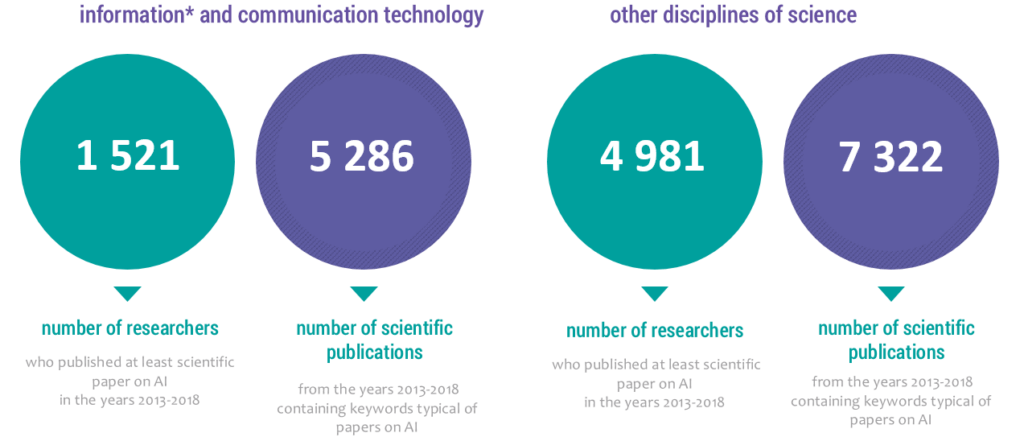
Number of AI researchers and number of AI scientific papers published by them in the period 2013-2018
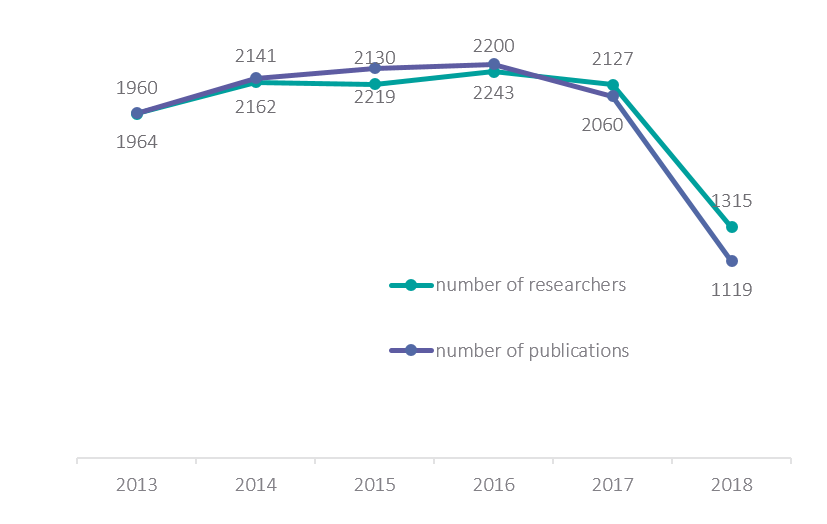
Rate of co-authorship and interdisciplinarity of publications on AI in the years 2013-2018
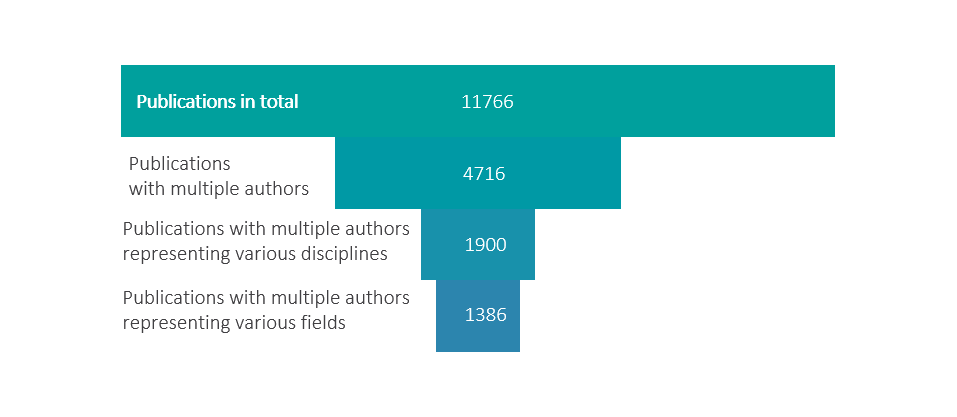
Source of two charts: OPI PIB own analysis based on data from the PSB, as of 07.05.2019.
The number of all AI researchers and of their publications between 2013 and 2017 remained stable and ranged between 2000-2200 researchers or publications. Data for 2018 are for illustrative purposes only as they are still being entered into the PSB.
Four out of ten publications on AI have more than one author. Forty percent of publications with multiple authors have been drafted by researchers representing various disciplines of science. Only 11.8% of all publications are a result of scientific collaboration of researchers representing various disciplines of science.
Number of natural science and engineering and technology researchers who published at least one paper on AI in the period 2013-2018, by discipline of science
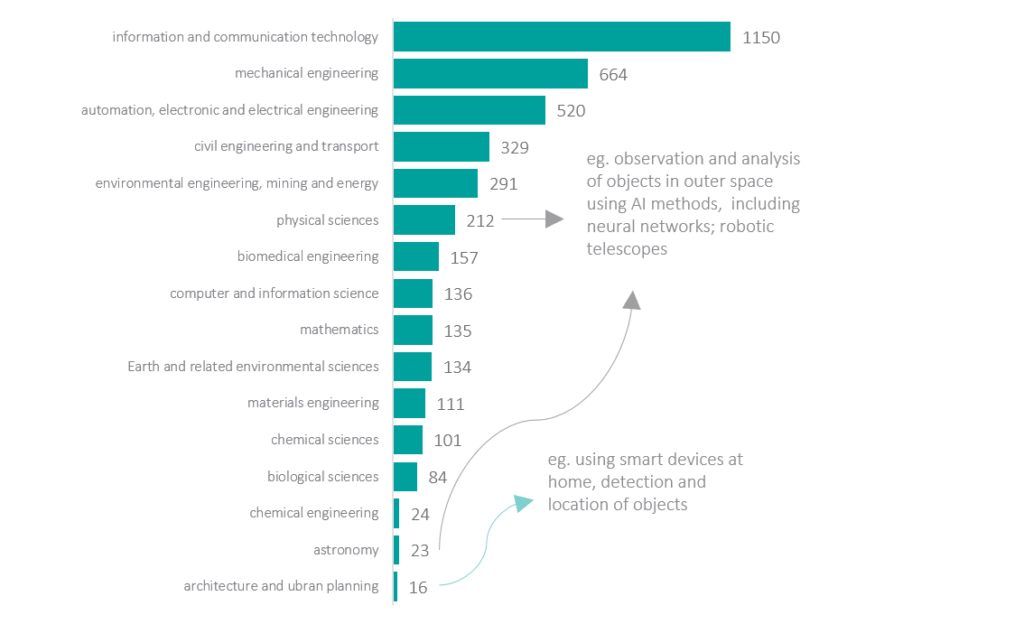
Source: OPI PIB own analysis based on data from the PSB, as of 07.05.2019.
Between 2013 and 2018, the highest number of AI researchers carried out studies in the area of engineering and technology (3262 researchers who indicated engineering and technology as their main discipline of science), with majority of them representing information and communication technology (1150 researchers). In the field of natural sciences, publications on AI were produced by a total of 825 researchers, with 136 of them indicating computer and information sciences as their main or only discipline of science.
It should be noted that artificial intelligence is of interest to researchers from numerous disciplines of science. Below you can find a chart depicting the number of AI researchers in the field of humanities, social sciences, theology, and arts. It follows from the analysis of the topics of publications prepared by those researchers that in the area of management and quality studies and economics and finance AI methods are applied to solve issues such as risk and competitiveness. In the area of law, philosophy and arts, analyses can be found of AI applications in all aspects of life. In the analysed period, scientific papers on AI were published by a total of 744 researchers from the field of social sciences and 85 researchers from the field of humanities.
Number of researchers from the field of humanities, social sciences and arts who published at least one paper on AI in the period 2013–2018, by discipline of science
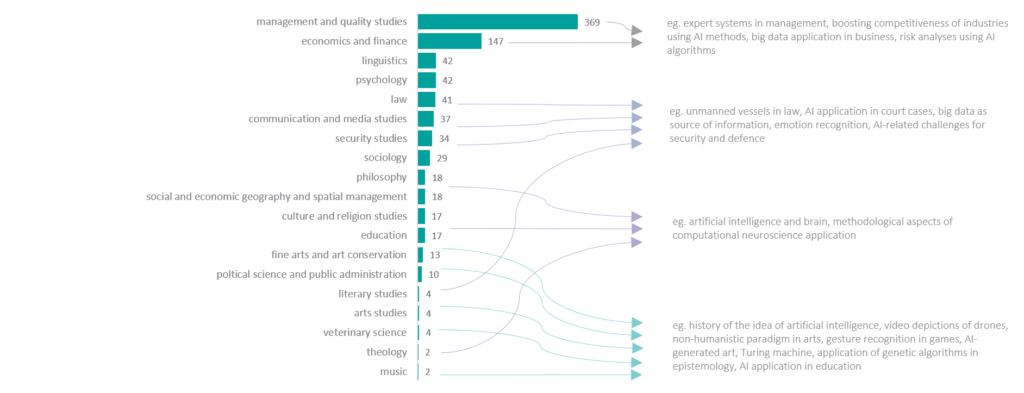
Source: OPI PIB own analysis based on data from the PSB, as of 07.05.2019.
Number of researchers from the field of medical, health and agricultural sciences who published at least one paper on AI in the period 2013–2018, by discipline of science

Source: OPI PIB own analysis based on data from the PSB, as of 07.05.2019.
AI methods are also applied in the field of medical and health sciences (a total of 262 researchers representing this field published papers on AI applications). It is also interesting to look at the topics of papers in the field of agricultural sciences, which were drafted by a total of 172 experts, mostly within three disciplines: agriculture and horticulture, animal science and fisheries, and nutrition and food technology.
Number of researchers who published one, two or at least three scientific papers on AI in the period 2013-2018, by academic degree or title
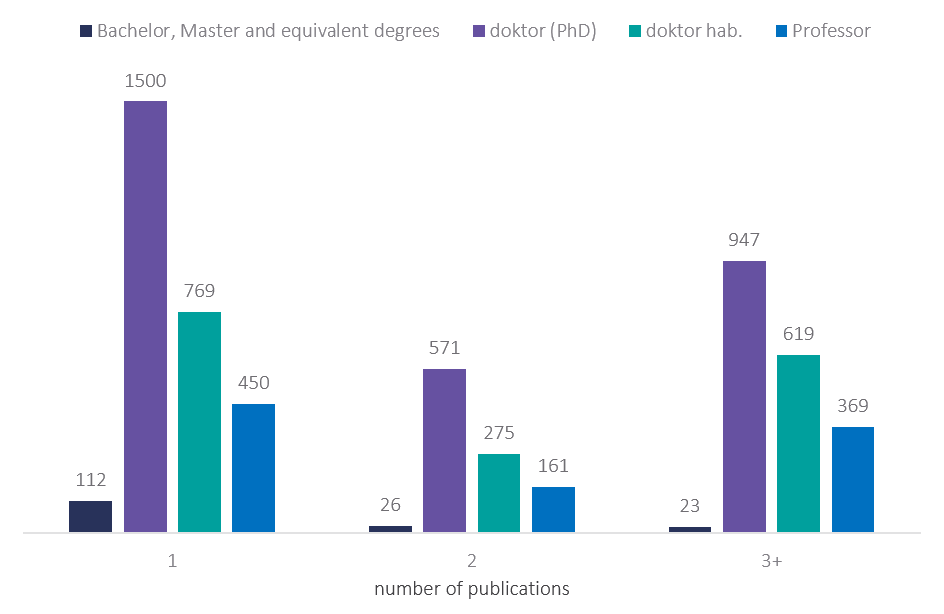
Source: OPI PIB own analysis based on data from the PSB, as of 07.05.2019
The topic of AI was raised in their publications mostly by researchers with the academic degree of doktor or higher (52%), with a small number of papers published by researchers with master’s or bachelor’s degree (or their equivalent). Of all AI researchers from all disciplines of science, 29% held the degree of doktor habilitowany and 17% were professors.
Within the six years analysed, one third of researchers published at least three scientific papers on AI, while almost half of researchers published no more than one paper.
Number of researchers who published at least one scientific paper on AI in the period 2013-2018, by year of birth
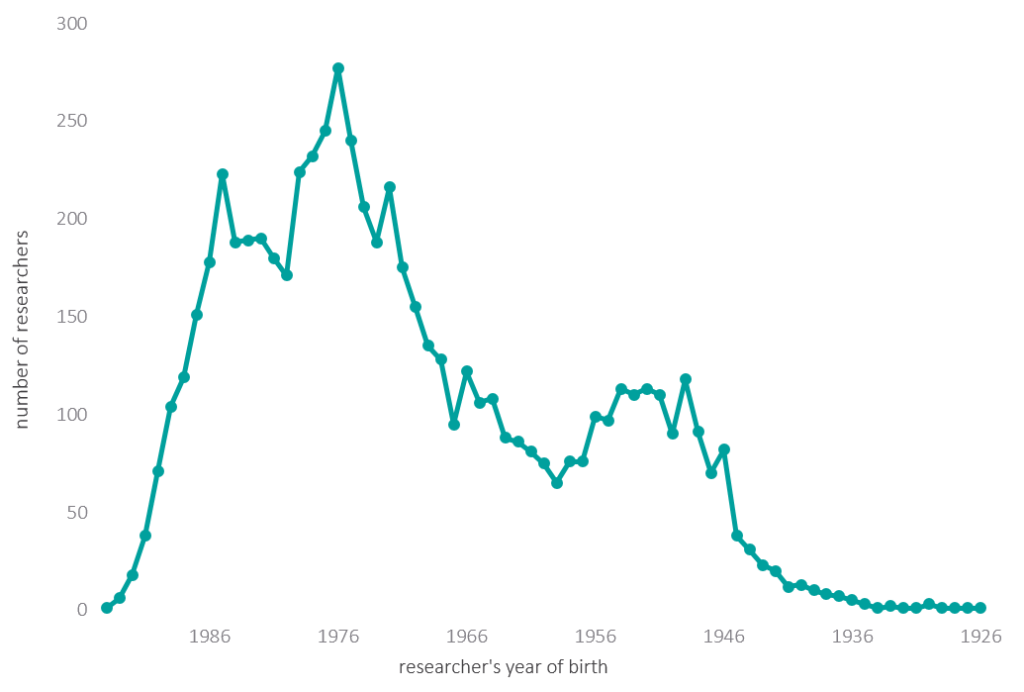
Source: OPI PIB own analysis based on data from the PSB, as of 07.05.2019.
The most numerous group of AI experts who publish their papers comprises researchers in their forties (2158 people) and researchers aged 30-39 (1693 people).
It should also be noted that the researchers who turned 60 or more in 2019 constitute almost one fourth of all AI experts who are active in terms of publishing their papers.
Share of scientific papers on IA published in the years 2013-2018 by type of paper and discipline of science
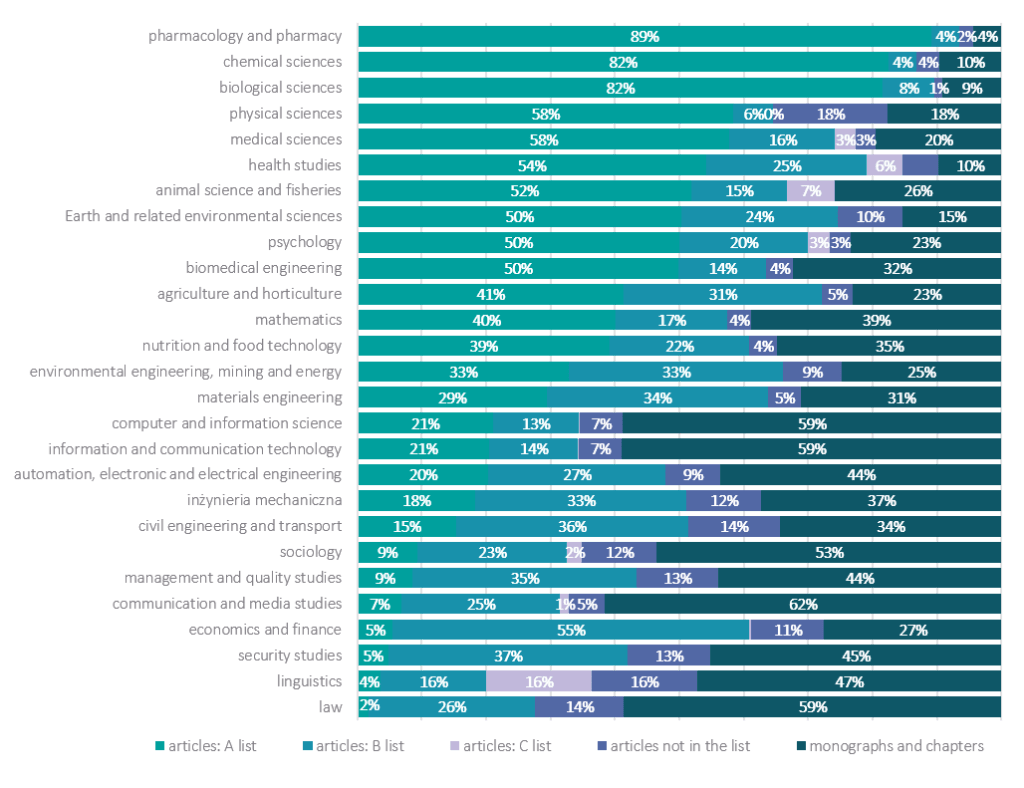
Source: OPI PIB own analysis based on data from the PSB, as of 07.05.2019.
Of all the publications on AI, 56% were articles published in scientific journals, while 44% were monographs or chapters published in collections of papers. Forty three percent of all articles were papers published in the so-called A list journals.
As the chart illustrates, the general statistics for individual disciplines of science are different. The biggest share of AI articles published in A-list journals was found in the area of chemical sciences (82%), biological sciences (82%) and physical sciences (58%). As for information and communication technology or computer and information sciences under natural sciences, the share was 21%. AI experts in computer science disciplines have a clear preference for monographs (which constitute 59% of the total number of papers prepared within these disciplines). They include, among other things, post-conference materials.
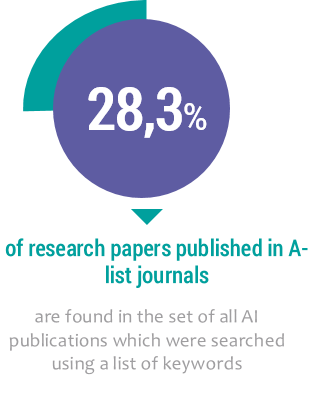
The most popular keywords appearing in publications of AI researchers in the period 2013-2018
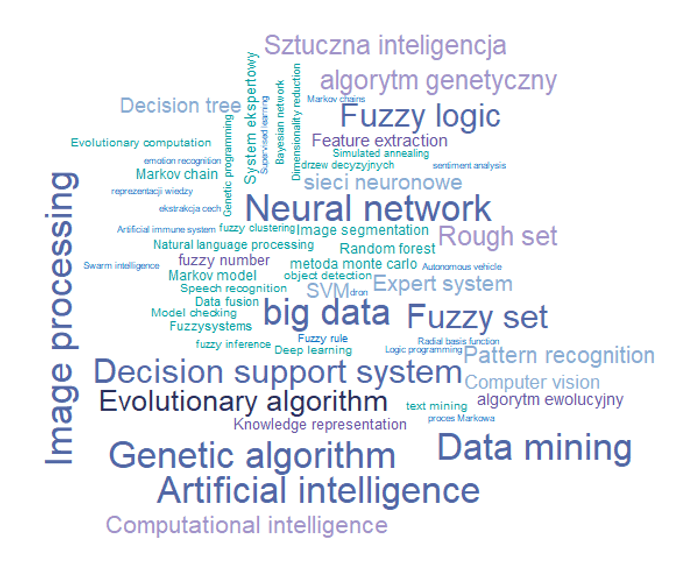
Source: OPI PIB own analysis based on data from the PSB, as of 07.05.2019.
In their publications, the authors of scientific papers on AI raised mostly the subject of artificial neural networks (1,822 publications contain phrase “neural network” in the title or the abstract).
Other most popular topics in the period 2013–2018 were image processing, genetic algorithms, data analysis (“data mining”, “big data”), decision support systems and fuzzy set theory (“fuzzy set”, “fuzzy logic”). The development of technology in these areas can be regarded as the main theme of artificial intelligence research in Poland.
The majority of papers were published in English – there is no single Polish term among the most frequently appearing keywords.
Ranking of research centres with the highest number of researchers who published scientific papers on AI in the period 2013-2018
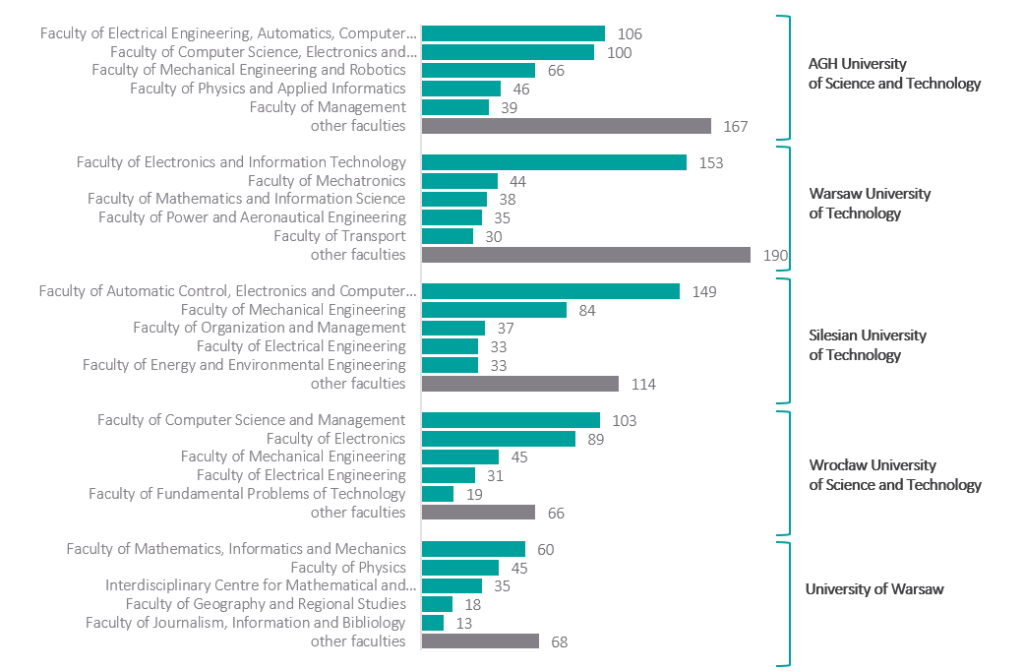
Source: OPI PIB own analysis based on the PSB, as of 07.05.2019.
The top five institutions in terms of the number of authors of AI research papers are: AGH University of Science and Technology, Warsaw University of Technology, Silesian University of Technology, Wrocław University of Science and Technology, and University of Warsaw.
Of all the above universities, the highest number of AI researchers is employed at departments related to computer and information sciences. It should be, however, noted that AI research is conducted also at other departments (cf. the above chart).
The table on the next page presents a ranking of twenty research centres where the majority of AI publications were prepared. In the case of the Systems Research Institute of the Polish Academy of Sciences, the average number of publications (authorship or co-authorship) for one researcher is almost eleven. There were over four research papers for one researcher at the Częstochowa University of Technology, Polish-Japanese Academy of Information Technology, and Wrocław University of Economics.
As for the share of articles from the so-called A-list in the total number of publications, the leading institutions are: University of Silesia in Katowice (44.6%), Systems Research Institute of the Polish Academy of Sciences (42.3%), Gdańsk University of Technology (32.7%), and University of Warsaw (31.4%).
Ranking of research centres with the highest number of scientific papers on AI in the period 2013-2018
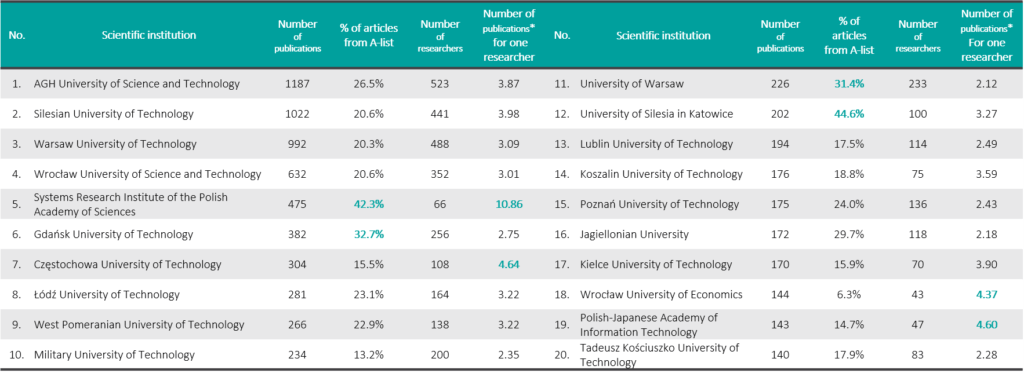
* Rate of authorship or co-authorship of publications on AI for one researcher from a given institution.
Source: OPI PIB own analysis based on the PSB, as of 07.05.2019.
Methodological appendices
Appendix 1
Method of selecting keywords for the analysis of data from the Polish Scientific Bibliography
The selection of AI publications and researchers was made using machine methods (automatic search of databases), based on a list of keywords. It was assumed that this would allow to identify research papers on AI methods, applications and social aspects of the development of new technologies, presenting either a narrow (technical) or a broad picture of artificial intelligence.
The list of keywords was developed in a four-step-process. First, a broad set of keywords was compiled on the basis of the literature on the subject. Next, it was verified by experts: practitioners and researchers specialising in the area of AI (six people in total). At this stage, we eliminated the words which wrongly identify AI papers or are not unique to AI publications. The experts also had the opportunity to present their own keyword proposal. The list developed in this way included 294 terms in English.
At the next stage, the list of words in English was translated into Polish. The translated list included all possible translation options, which means that there were eventually more keywords in Polish than in English. The applied search technology enabled us to identify papers on the basis of singular, plural and declined words from the list.
At the final stage, after searching for publications in the PSB, a sample of titles and abstracts was selected in order to finally verify the effectiveness of the selected keywords in the identification of publications on AI. At this stage, a total of 29 phrases were eliminated from the set as they were too ambiguous to precisely identify papers concerning AI. Moreover, four phrases (emotion recognition, expression recognition, object recognition, pattern recognition) were removed from the list of keywords only for certain disciplines of science (e.g. psychology, linguistics, medical sciences) where the phrases are used in a different context. The verification of the list of keywords therefore allowed for the removal of excessively broad concepts that are not an exclusive distinguishing feature of artificial intelligence (e.g. clustering, casualty, Python, smart devices). Selected terms, however, are so broad in their meaning that they also identify narrower phrases (e.g. the term “convolutional neural network” identifies “neural network”).
Statistics prepared with the use of such a list of keywords are a good approximation of real-world values. The developed list can be extended in the future to include new keywords and other foreign languages. It can also be consulted with a different pool of experts.
Key sources for the identification of the keyword lists:
-
Association
for the Advancement of Artificial Intelligence,
AITopics
https://aitopics.org/search -
China
Institute for Science and Technology Policy at Tsinghua University
(2018) China AI
Development
http://www.sppm.tsinghua.edu.cn/eWebEditor/UploadFile/Executive_susmmary_China_AI_Report_2018.pdf -
Corea F.
(2018) AI Knowledge Map: How To Classify AI
Technologies
https://www.forbes.com/sites/cognitiveworld/2018/08/22/ai-knowledge-map-how-to-classify-ai-technologies/#35a4feaf7773 -
Glossary of
artificial
intelligence
https://en.wikipedia.org/wiki/Glossary_of_artificial_intelligence -
Goodfellow I.
et. al. (2019) Deep
Learning
https://github.com/janishar/mit-deep-learning-book-pdf/blob/master/complete-book-pdf/deeplearningbook.pdf.
Appendix 2
Method of selecting top computer and information science journals on AI to analyse data from the Polish Scientific Bibliography
The set of IA publications in computer and information science journals to be analysed was determined on the basis of a list of Top Journals for Computer Science and Electronics published by Guide2Research.com. The website gathers data on research and international scientific conferences. In the tab “Top 600 Journals”, a list of international journals with impact factor is presented, divided by thematic areas under computer and information sciences.
For the purposes of the analysis, the following lists were used:
- 111 journals from the area of machine learning, data mining and artificial intelligence,
- 57 journals from the area of image processing and computer vision,
- 28 journals from the area of human computer interaction.
The analysis takes into account all journals from the above lists in which scientists reporting their research achievements to the Polish Scientific Bibliography system published their articles. It should be noted that those journals are included in the list of ranked journals of the Polish Ministry of Science and Higher Education in the so-called A list.
Source for the list of top computer and information science journals on AI:
Please send any questions regarding this study to: labstat@opi.org.pl